
"Ram and Laxman have come to our village," said
the orange-turbaned villager in Nagar village, Rajasthan – the last stop on the
fourth Pani Yatra. "In the myths, they defeat evil," he continued.
"Here they are defeating the drought."
The Ram and Laxman who have come to rural Rajasthan are not
the heroes of the Ramayan, but Ram Jilal and Laxman Singh of the Gram Vikas
Navyuvak Mandal, Laporiya (GVNML) – two of the many community water warriors that the
yatris met on their journey.
The Pani Yatra, from 14-19 October 2001, was
organised by the Centre for Science and Environment (CSE) to help raise awareness about
rural water harvesting. The twenty four participants, from all over India and Sri Lanka,
had a chance to see firsthand the community water management successes of Rajasthan and
talk with both villagers and community organisers. The yatris also got to learn
from each other, as the tour brought together people with a common interest in water but a
wide variety of backgrounds, including professors, engineers, architects, planners, donor
agency and non-governmental organisation (NGO) leaders, and development workers.
In six days, the yatris covered more than 1,000 km
of Rajasthan's bumpy backroads by bus, jeep, and foot in their search for water harvesting
structures like chaukas, johads, and anicuts, and the people who build them.
The village of Bhaonta-Kolyala in Alwar District, recipient
of the 2000 Joseph C. John award for India's best environmental community, was the first
stop. There, amidst herds of goats gathering to drink, the yatris saw a series of
anicuts - concrete-reinforced check-dams - constructed by villagers and Tarun Bharat Sangh
(TBS), an Alwar-based NGO. Down the road in Hamirpur, the yatris saw one of TBS's
first anicuts, built in the late 1980s. The river Arvari, in the catchment of which TBS
has built more than 300 johads, flows through Hamirpur. Twenty years ago, it was
dry for nearly half the year. Now it flows year-round.
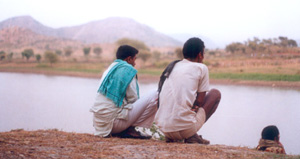 |
| Villagers
at the Hamirpur anicut. |
After Hamirpur, the yatris drove on to TBS's Ashram
at Bhikampura village, where they were greeted by singing villagers, cool mats under the
stars, and dinner. TBS's secretary Rajendra Singh, winner of the 2001 Magsaysay Award,
talked late into the night with the yatris, the villagers, and other TBS activists.
Several yatris challenged Singh on TBS’s focus
on water and apparent omission of other development objectives like roads and education.
Singh explained that in Alwar district, water must be the first step in development.
Through successful water projects, TBS has developed trusting relationships in dozens of
villages. Roads and education are important too, but water comes first.
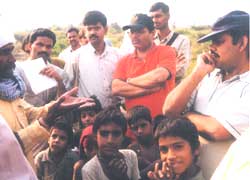 |
| Yatris
and village children in discussion with Nanak Ram Gujar at Haripura |
The yatris and Singh also talked about the merits
and potential pitfalls of local resource governance. In the Arvari watershed, TBS has
helped to set up the Arvari Parliament, an independent resource governance board with its
own set of rules and its own local management authority. Some yatris worried about
the long-term consequences of setting up a powerful local government in defiance of the
state and district regimes. Singh countered that the state and the gram panchayats were
not doing any actual management work before the Arvari Parliament was established, so
it’s not as though the local managers are taking over their responsibilities. Rather,
the Arvari Parliament fills a management vaccuum.
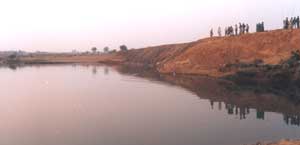 |
| Yatris on the
Lava ka Baas johad. |
The next afternoon the yatris visited the johad,
or earthen dam, at the village of Lava ka Baas, made famous by the Rajasthan irrigation
department’s efforts to remove it in July, 2001. The johad - 14 meters tall
and 200 meters long – prompted mixed exclamations from the yatris - from
"It's so big!" to "It makes me so sad! - this was built by heavy machinery,
not by villagers," to "Isn't it superb!" Chalk arrows now direct visitors
from the main road to the controversial structure, which has lately made Lava ka Baas a
busy place. [link to more information on Lava ka Baas].
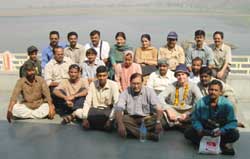 |
| Group
photo at Silser Lake |
The next morning, the yatris left Alwar for Jaipur
and Tonk districts, stopping for tea at one of the area’s oldest
continuously-operating water harvesting structures, the dam at Silser lake built by
Maharaja Vinay Singh in 1845 [group photo]. The lake once supplied water to the township
of Alwar via a 22-km gravity flow stone aqueduct; today, it provides year-round water to
villagers in the valley downstream of the dam.
The fourth day of the journey found the yatris
wandering through the village of Nagar with GVNML’s Laxman Singh. Several yatris,
veterans of rural development work, described it as the best-planned village they'd ever
seen. The houses, built over the past 25 years, line up neatly on the street, each with
two neem trees in front and rooftop water harvesting systems to direct rainwater to the
trees. A large community centre serves as both temple and meeting house, with access not
restricted by caste or gender. Overflow water from the handpump on the edge of the village
is directed to a trough where animals can drink, while wastewater from washing is sent in
a separate direction to percolate into the ground.
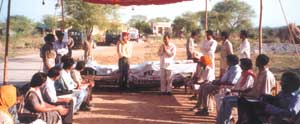 |
| Breakfast
with Laxman Singh at the Gram Vikas Navyuvak Mandal, Laporiya ashram in Nagar village. |
On the outskirts of Nagar, the yatris visited the
village's reservoir - a 500-year-old structure that was repaired in 1990 and has now made
a 200 meter by 100 meter lake. Dozens of villagers swam, bathed, and washed clothes in the
water. The yatris were tempted to join them.
After Nagar, Laxman Singh led the yatris for a
three-hour tour of the pastureland surrounding the village of Gugardoo. In the last
decade, Singh and the villagers have been building chaukas -- a system of low berms
and shallow pits -- to recharge the local groundwater and regenerate the communal
pastureland. [photos] This work has begun to rehabilitate the traditional animal husbandry
economy.
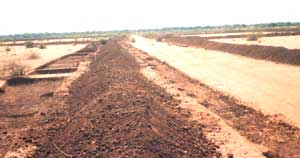 |
| Close-ups of the chauka system near Gugardoo village. |
The chauka system divides the open, grassy plains
into 100-hectare cells. Within each cell, the runoff is carefully managed with the system
of berms to ensure that the monsoon rainwater, which comes in intense bursts, is spread
over the entire area. At the downhill end of the cell, the excess water collects in a
tank, which is used for watering livestock. Building the berms requires moving a lot of
earth, but the villagers get double-duty for their work by making clever use of the empty
pits as well. Their shallow, flat-bottomed pits turn into micro-marshes during the monsoon
season. Grasses that thrive in wet environments are seeded in the pits to maximise forage
production.
On the last night of the yatra, the partipants were
treated to a 14-course traditional Rajasthani dinner at the GVNML ashram, followed by a
slide show by Laxman Singh. The power went out soon after, but the yatris and Singh
talked on under the starry country sky.
Friday morning the yatris boarded the bus for the
return to Delhi. On the way, they stopped at the lush Chamunda Mata ka Mandir temple
grounds in Bairowa Ki Dhani. Here, villagers have harvested water and built an irrigation
system to grow trees and grass within the temple fences. The sale of grazing rights on the
temple grounds pays the annual maintenance costs and helps the villagers put on an annual
springtime fair.
After four more hours on the road and a last meal together
at the Amer fort, the yatris sang the bus home to Delhi with 250 kilometers of
Hindi film favorites.
|
|










